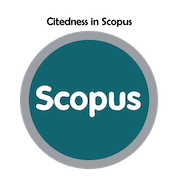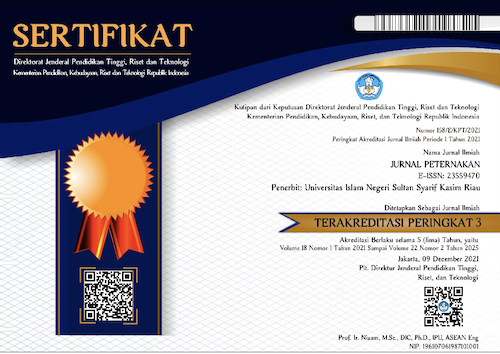Identifikasi Bakteri Asam Laktat (BAL) dari Fermentasi Limbah Kangkung (Ipomoea aquatica) sebagai Penghasil Bakteriosin Alami
Abstract
ABSTRAK. Probiotik merupakan salah satu alternatif yang aman untuk digunakan sebagai pengganti antibiotik. Namun, produksi probiotik umumnya memerlukan biaya yang relatif tinggi. Oleh karena itu, perlu dikembangkan probiotik alami dari bahan baku yang mudah dibudidayakan dan berharga terjangkau, seperti limbah kangkung yang difermentasi dengan bakteri asam laktat (BAL) dalam yoghurt. Tujuan penelitian adalah untuk mengetahui jenis dan potensi BAL hasil fermentasi limbah kangkung serta kemampuan antibakteri terhadap Salmonella typhi dan Escherichia coli. Jenis penelitian yang digunakan adalah deskriptif. Parameter yang diukur yaitu uji morfologi makroskopis BAL, jumlah koloni, aktivitas antibakteri terhadap Salmonella typhi dan Escherichia coli, dan uji bakteriosin BAL. Hasil penelitian menunjukan jenis BAL yang teridentifikasi adalah Lactobacillus dengan total BAL 12,6 × 10⁵ CFU/mL yang memenuhi jumlah standar minimum probiotik (minimal 10⁶ CFU/mL untuk aktivitas probiotik yang efektif). Oleh karena itu, dapat disimpulkan limbah kangkung memiliki potensi untuk dikembangkan sebagai media pertumbuhan bakteri asam laktat (BAL) sebagai probiotik alami.
Kata kunci: Antibakteri, limbah kangkung, probiotik, unggas
Identification of Lactic Acid Bacteria (LAB) from Fermented Water Spinach (Ipomoea aquatica) Waste as Natural Bacteriocin Producers
ABSTRACT. Probiotics are a safe alternative to antibiotics. However, probiotic production generally requires relatively high costs. Therefore, it is necessary to develop natural probiotics from raw materials that are easy to cultivate and affordable, such as water spinach waste fermented with lactic acid bacteria (LAB) in yogurt. The purpose of this study was to determine the type and potential of BAL from fermented kale waste and antibacterial ability against Salmonella typhi and Escherichia coli. The type of research used was descriptive. Parameters measured were macroscopic morphology test of BAL, number of colonies, antibacterial activity against Salmonella typhi and Escherichia coli, and BAL bacteoriocin test. The results showed that the type of BAL identified was Lactobacillus with a total LAB of 12.6 × 10⁵ CFU/mL which met the minimum standard amount of probiotics (at least 10⁶ CFU/mL for effective probiotic activity). Therefore, it can be concluded that kale waste has the potential to be developed as a growth medium for lactic acid bacteria (BAL) as a natural probiotic.
Keywords
Full Text:
PDF (Bahasa Indonesia)References
Ahmad, V., M. S. Khan., Q., M. S. Jamal., M. A. Alzohairy., M. A. Al Karaawi, & M. U. Siddiqui. 2017. Antimicrobial potential of bacteriocins: in therapy, agriculture and food preservation. Inter. J. Antimicrob. Agents. 49(1):1-11.
Aleman, R. S., I. Montero-Fernández., J. A. Marcía., S. A. S. Maldonado, & D. Martín-Vertedor. 2024. Application of fermentation as a strategy for the transformation and valorization of vegetable matrices. Fermentation. 10(3):124.
Ardilla, Y. A., K. W. Anggreini, & T. P. D. Rahmani. 2022. The role of indigenous lactic acid Bacteria Genus Lactobacillus in the fermentation process of Durian (Durio zibethinus) for Tempoyak production. Berkala Ilmiah Biologi.13(2):42-52.
Aqil, H., D. Risdianto, & I. Hartati. 2015. Isolasi dan pengayaan bakteri Lactobacillus dari rumen Sapi. Momentum. 11(2):93-98.
Bangar, S. P., S.Suri., M. Trif, & F. Ozogul. 2022. Organic acids production from lactic acid bacteria: A preservation approach. Food Bioscience. 46(1):1-16.
Du, Z., S. Yamasaki., T. Oya, & Y. Cai. 2023. Cellulase–lactic acid bacteria synergy action regulates silage fermentation of woody plant. Biotechnology for Biofuels and Bioproducts.16(1): 125.
Falakh, M. F, & M. T. Asri. 2022. Uji potensi isolat bakteri asam laktat dari nira siwalan (Borassus flabellifer L.) sebagai antimikroba terhadap Salmonella typhi. LenteraBio. 11(3):514-524.
Finanda, A., Mukarlina, & Rahmawati. 2021. Isolasi dan karakterisasi genus bakteri asam laktat dari fermentasi daging buah pisang kepok (Musa paradisiaca L.). Jurnal Protobiont. 10(2): 37–41.
Flach, J., M. B. van der Waal, M. van den Nieuwboer, E. Claassen, & O. F. Larsen. 2018. The role of underexposed food matrices in probiotic products: Reviewing the relationship between carrier matrices and product parameters. Critic. Rev. Food Sci. Nutrit. Res. 58(15):2570-2584.
Hamidah, M. N., L. Rianingsih, & Romadhon. 2019. Aktivitas antibakteri isolat bakteri asam laktat dari peda dengan jenis ikan berbeda terhadap E. coli dan S. aureus. Jurnal Ilmu dan Teknologi Perikanan. 1(2):11-21.
Ismael, M., M. Huang, & Q. Zhong. 2024. The bacteriocins produced by lactic acid bacteria and the promising applications in promoting gastrointestinal health. Foods. 13(23): 1-26.
Jha, R., R. Das., S. Oak, & P. Mishra. 2020. Probiotics (direct-fed microbials) in poultry nutrition and their effects on nutrient utilization, growth and laying performance, and gut health: a systematic review. Animals. 10(10):1863.
Khasanah, H., D. E. Kusbianto., L. Purnamasari., J. F. dela Cruz, D. C. Widianingrum, & S. G. Hwang. 2024. Modulation of chicken gut microbiota for enhanced productivity and health: A review. Vet. World. 17(5):1073-1083.
Madigan, M. T., J. M. Martinko., K. S. Bender., D. H. Buckley, & D. A. Stahl. 2015. Brock Biology of Microorganisms. 14th Ed. Pearson, Boston. 143-182
Mirsalami, S. M, & M. Mirsalami. 2024. Effects of duo-strain probiotics on growth, digestion, and gut health in broiler chickens. Vet. Anim. Sci. 24(4):1-13.
Mulyani, S., K. M. F. Sunarko, & B. E. Setiani. 2021. Pengaruh lama fermentasi terhadap total asam, total bakteri asam laktat dan warna kefir belimbing manis (Averrhoa carambola). Jurnal Ilmiah Sains. 21(2):113-118.
Lv, X., Y. Lin., Y. Jie., M. Sun., B. Zhang., F. Bai, & J. Li. 2018. Purification, characterization, and action mechanism of plantaricin DL3, a novel bacteriocin against Pseudomonas aeruginosa produced by Lactobacillus plantarum DL3 from Chinese Suan-Tsai. European Food Res. Technol. 244(2):323-331.
O’Connor, P. M., T. M. Kuniyoshi., R. P. Oliveira., C. Hill., R. P. Ross, & P. D. Cotter. 2020. Antimicrobials for food and feed; a bacteriocin perspective. Curr. Opi. Biotechnol. 61 (1): 160-167.
Prasetyo, A. F., M. Y. M. Ulum., B. Prasetyo, & J. I. Sanyoto. 2020. Performa pertumbuhan broiler pasca penghentian antibiotic growth promoters (AGP) dalam pakan ternak pola kemitraan di kabupaten jember. Jurnal Peternakan. 17(1):25-30.
Pujato, S. A., D. J. Mercanti., M. B. Marcó., M. L. Capra., A. Quiberoni, & D. M. Guglielmotti. 2024. Bacteriocins from lactic acid bacteria: strategies for the bioprotection of dairy foods. Front. Food Sci. Technol. 4(8):1-8.
Puspitaningrum, T., L. D. Mahfudz, & M. H. Nasoetion 2021. Potensi bawang putih (Allium sativum) dan Lactobacillus acidophilus sebagai Sinbiotik untuk meningkatkan performans ayam broiler. Jurnal Sain Peternakan Indonesia. 16(2):210-214.
Rahman, M. A., A. Haque., T. Ahmad., S. Mahmud., S. N. Sohana., M. R. Hossain., MR, N. C. Barman., M. Badiruzzaman., T. Hossain., M. S. Haque., M. E. Uddin, & R. Ahmed. 2019. Isolation, identification and antibiotic sensitivity pattern of Salmonella spp. from locally isolated egg samples. American J. Pure Appl. Biosci. 1 (2): 1-11.
Rahmiati, R, & M. Mumpuni. 2017. Eksplorasi bakteri asam laktat kandidat probiotik dan potensinya dalam menghambat bakteri patogen. Elkawnie: J. Islamic Sci. Technol. 3(2):141-150.
Soeharsono, & L. Andriani. 2010. Tinjauan saintifik probiotik. In. Probiotik: Basis Ilmiah, Aplikasi dan Aspek Praktis. Soeharsono (ed). Widya Padjajaran. Bandung. 47-58.
Stanley, P. L., T. A. Winslow, & I. Pillay. 2017. Detection of presumptive pathogens in ground beef from supermarket and farmers' market sources. Georgia J. Sci. 75(2):1-11.
Tanjung, M. T., R. Fevria., D. Handayani, & L. Advinda. 2023. Jumlah bakteri asam laktat (BAL) pada sauerkraut dari kubis ungu (Brassica oleracea var. capitata L.f. Rubra) dengan konsentrasi garam yang berbeda. Biocelebes. 17(1):38-45.
Utomo, G. S. M., S. Hidanah., M. A. Al Arif., W. P. Lokapirnasari, & W. M. Yuniarti. 2022. Business analysis of probiotic administration of lactic acid bacteria on the performance of kampung super chicken. Jurnal Medik Veteriner. 5(1):87-93.
Vera-Peña, M. Y, & W. L. R. Rodriguez. 2020. Effect of pH on the growth of three lactic acid bacteria strains isolated from sour cream. Universitas Scientiarum. 25(2):341–358.
Wea, R., B. B. Koten, & E. V. Mohamad. 2021. Jumlah total bakteri asam laktat dan pH pakan cair berbahan biji asam utuh pada lama fermentasi berbeda. Partner. 26(1): 1544-1549.
Yunilas, Y., A. Zuliyanti., E. Mirwandhono, & T. Malvin. 2022. Potensi dan karakteristik larutan mikroorganisme lokal (MOL) berbasis limbah sayur sebagai bioaktivator dalam fermentasi. J. Livestock Anim. Health. 5(2):53-59.
Zangeneh, M., S. Khorrami, & M. Khaleghi. 2020. Bacteriostatic activity and partial characterization of the bacteriocin produced by L. plantarum sp. isolated from traditional sourdough. Food Sci. Nutrit. 8(11):6023-6030.
Zalila-Kolsi, I., A. Ben-Mahmoud, & R. Al-Barazie. 2023. Bacillus amyloliquefaciens: Harnessing Its Potential for Industrial, Medical, and Agricultural Applications—A Comprehensive Review. Microorganisms. 11(9):1-19.
DOI: http://dx.doi.org/10.24014/jupet.v22i2.35313
Refbacks
- There are currently no refbacks.
Jurnal Peternakan has been accredited by Sinta 3 : Number 158/E/KPT/2021
Starting from Vol. 18 No. 1 Year 2021 to Vol. 22 No. 2 Year 2025
Jurnal Peternakan Indexed By:
Editorial Office:
Jurnal Peternakan
Faculty of Agriculture and Animal Science, State Islamic University of Sultan Syarif Kasim Riau.
H.R. Soebrantas street KM. 15,5 Panam – Pekanbaru city.
E-mail: jurnal.peternakan@uin-suska.ac.id
ejournal: http://ejournal.uin-suska.ac.id/index.php/peternakan

Creation is distributed under the Creative Commons Attribution 4.0 International License. View Mystats















